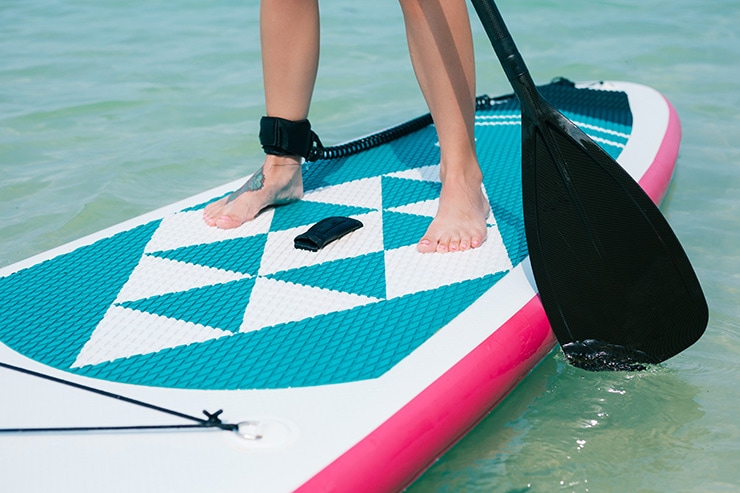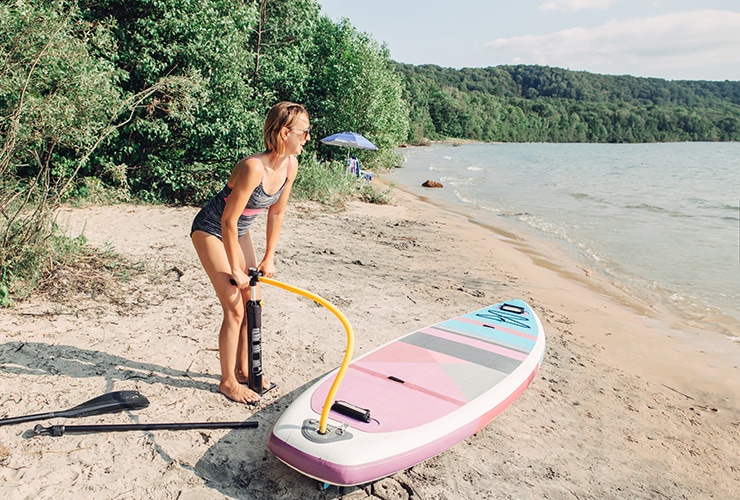If you’re new to SUP, and you’re worried about if your board will lose air, you can rest easy. Today’s quality built inflatable paddle boards do a great job holding onto their air, and gradual or repetitive air loss is not something you should really have to deal with.
Normally, any air loss in a SUP board should not be substantial enough that you’d be able to notice it. So, in the event that your paddle board feels like it’s lost air you may want to do some closer investigation. A leaky inflatable could signal that there is something else going on.
Today, I’ll go over the details of what is normal and what’s cause for concern when it comes to your inflatable paddle boards leaking air. I’ll also share with you my proven tips for limited air leakage, no matter the type of inflatable stand up paddle board you have.
RELATED: Discover the Best All Around Inflatable SUP Boards of 2024
What Causes Inflatable Paddle Boards to lose Air?
Air loss in an inflatable paddle board can happen for a variety of reasons, with some reasons being more worrisome than others.
It can be normal for inflatable paddle boards to lose a bit of air, especially if you are storing them while inflated for an extended period of time. However – you shouldn’t be losing all the air! If you find your inflatable stand up paddle board has deflated between uses, this is surely a sign that you have a problem.
Quality SUPs should not lose air for no apparent reason. Cheaper models might lose more air over time due to poorer materials and poor construction like weakly glued seams.
Air loss can also happen because of pinhole punctures, tears, seam issues (such as a broken seam) or exposure to the elements. Here are some of the main culprits to blame for leaky air.
ALSO READ: Why are paddle boards so expensive?

A General Loss of Air Pressure
If you store your SUP while it’s fully inflated, then you can expect to deal with a general loss of air. However, this will really only happen if you’ve stored your inflatable for longer than a couple of months.
A general loss of air can happen when air seeps out through the pores of your SUP’s material. If the temperature of the air drops, your inflable’s pressure can drop as well.
Conversely, if the temperature rises, the air in your inflatable can expand and put extra pressure on the seams, causing small ruptures that way.
A Puncture
One of the more common ways you’ll experience loss of air pressure in your inflatable is due to a puncture. If you accidentally rip, tear, or pop your inflatable, it will gradually lose a substantial amount of air.
Depending on how big of a tear you have, you’ll start noticing the loss of air within a couple of minutes or hours.
A Leaking or Faulty Valve
A leaking valve is another common culprit for loss of air in an inflatable SUP. If you have damaged your valve system, this can cause air to escape. Sometimes, it’s as simple as incorrectly closing up your valves, or not noticing a loose valve.
A leaking valve can result from sand, dirt, and other debris getting caught in your valve’s ring. If the ring is damaged or does not close properly this is enough to create a passage for air to leak out. You’ll need to repair or replace the valve to keep air from seeping out.
A Broken Seam
Broken seams can also result in leaking air. This type of leaks are usually the hardest to figure out because it can be difficult to locate a leaky seam. A faulty seams can happen for a variety of reasons, with over-inflating your SUP typically being the culprit.
Unlike a puncture or faulty valve, you’ll have to carefully inspect the seams of your inflatable paddle boards to find the leak. Along with being the trickiest to find, they are also the most difficult type of punctures to repair too.

Sun Exposure
That’s right… too much sun can cause air to leak out of your inflatable paddle board. The sun’s UV rays can cause the surface of your inflatable board to weaken, as can extreme heat.
Once the rubber or PVC material is weakened, air can seep out much easily. This weakened material of your inflatable is more likely to suffer tears and pinhole leaks as well.
Over Inflating Your Paddle Board
Another common culprit for leaky inflatable paddle boards are ones that are overinflated. When you are over inflating an SUP, you are creating more air than you should.
This extra air pressure will push against the seams of your paddle board as the air looks to escape. Overtime, the seams will weaken and may cause little ruptures or tears which air can escape out of.
How to Minimize Air Loss in Your Inflatable Sup

Very minimal and gradual loss of air inside your SUP over an extended period of time is normal. Still, there are ways you can minimize air loss in inflatable SUPs.
The number one way to minimize air loss is by taking proper care of your inflatable paddle board. Caring for your board properly allows you to maintain the integrity of the material of your paddle boat. Let’s go over easy to implement methods that will keep the air inside your paddle board right where it should be.
- Store your inflatable properly: Store inflated or deflated, but keep it out of the elements and keep it clean. Weather, dirt, mildew and other environmental factors can weaken your paddle board and compromise its integrity
- Store your paddle board out of the sun: Harmful UV rays can weaken your paddle boards material, so don’t keep it in direct sunlight or exposed to high heat for long periods.
- Don’t store other items on top of your board: Weight on your inflated board can weaken the integrity of the pvc material and your inflatable sups seams. In turn, this extra pressure can cause air to leak out.
- Do not over inflate your SUP: Only inflate to your boards recommended PSI. Inflating to the max PSI will result in a hard paddle board inflated to it’s optimum pressure; so it makes for a better paddling experience anyway.
- Take care when out paddle boarding: Taking care not to bump, scrape or damage your board will go some way toward maintaining its integrity. So, practice a bit of common sense!
Repairing a Leaky Inflatable Sup
Opting for an inflatable board over a hard paddle board means that the risk of puncture comes with the territory. If you do sustain a puncture on your SUP then you will need to repair it (most quality inflatables come with a puncture repair kit).
Your SUP board won’t lose air quickly and deflate on you while you’re in the water, even if you’ve sustained damage. Rather, you should be able to feel a gradual loss of rigidity in your paddle board.
Once you know you have a puncture, your next mission is to find it and repair it. The type of repair depends on the type of puncture you have; pinhole leaks may require a simple glue patch, but for more extreme punctures, like tears, you’d need to use a patch.
Not all inflatable paddle boards can be repaired using the same type of patch because of the material they are made out of. Always follow your manufacturer’s guidance on repairing punctures for your inflatables.
So, Do Inflatable Paddle Boards Lose Air?
If you’ve ever wondered ‘do inflatable paddle boards lose air?’ you’re not alone – but hopefully I’ve put your mind at ease somewhat regarding that question. Inflatable stand up paddle boards do lose air, very gradually, over time – but if air escapes more quickly than that, it’s likely you have a problem.
Something as simple as a faulty seam can hinder your board’s ability to hold air. While quality inflatables shouldn’t have problems like seam issues, faults do happen. If you’re sure you haven’t accidentally hit any sharp objects and caused a puncture, check for seam issues and leaking valves.
The cause of air loss can always be identified – and with proper care and maintenance, you shouldn’t have to deal with it at all.
I hope my guide has helped you understand how to best care for your paddle boards so that you can avoid this nuisance. Share your tips for minimizing air loss on your inflatable boards in the comments below!
Happy paddling!

